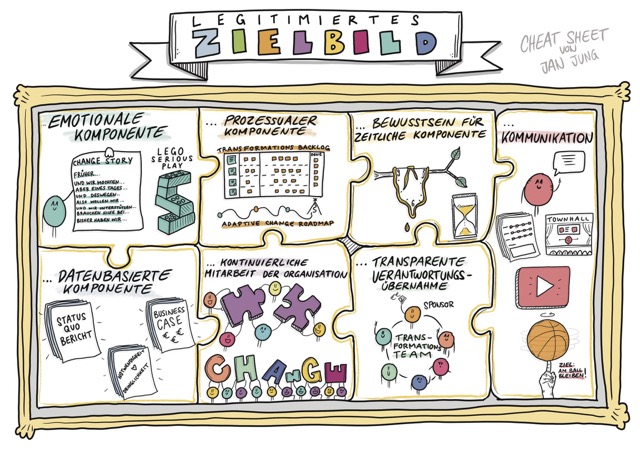Phew! What does the start of an agile transformation involve?
If you're also asking yourself this question, you've come to the right place. In this short series on the start of (agile) transformations, we want to address this question and shed light on the stages that are relevant to us.
The first blog post dealt with the legitimized status quo as an essential background for a change project. In the second part of the series, we look at the components of a legitimized target image.
The visualization is intended to serve as a small cheatsheet. The blog article follows it and describes the essential content.

Let's get started!
You can think of a target image as a kind of change cocktail. It requires the right dosage of ingredients (too much of one and it quickly becomes undrinkable). We have tried to prepare the essential ingredients of the Change-on-the-Beach for you.
Data-based component:
A data-based component of the target image is important in a business context: in practice, it is often used to underpin the necessity and urgency of the change. You can make good use of the results of the legitimized status quo here.
Key questions: What data can we use to recognize that the change is successful? Which data should change/generally improve as a result of the change?
Emotional component:
In addition to the data-based/rational components for the target image, it must also pick up the people affected by the change on an emotional level. People should not only know the figures, but ideally also have an idea of what the NEW and UNKNOWN could feel like in a positive way. The change story technique helps us here: it summarizes the change project briefly and concisely and helps to develop an emotional idea of the new. Lego Serious Play also has a raison d'être here. Building/designing a haptic target state together connects with people on a different level than a purely data-based target image. Essential questions: How can I imagine the new? Where am I as a person in the new? If applicable, how does the new feel?
Processual component:
The process-related component answers the question: How do we achieve the desired target image? In terms of content, the target image phase is not yet the right time to plan the content of the change. Nevertheless, it helps enormously in communication if people get an idea of the overarching process of the change. Here we rely on the design of a transformation backlog and an adaptive change roadmap, which shows the most important stages of the journey in terms of content (OBACHT: not a timeline with a fixed blueprint but an initial idea).
Continuous cooperation of the organization:
Similar to achieving the legitimized status quo, we can only achieve legitimization of the target image through the continuous cooperation of the organization. It must be clear that the change is not just done by a small group (transformation team) as if by magic, but that this is a task for the organization. For you as change facilitators: Develop participation formats in which people can really work together and contribute. This will increase the likelihood that the change will be accepted and supported by more people (IKEA effect).
Awareness of temporal components:
As humans, we are extremely bad at estimating how long a time-stable change in our behavior really takes. The scientific results here also show an enormous variation. Essential for you: The target picture should not conceal the fact that changing organizational patterns is a time-consuming project. It can sometimes take years for a new trainee to join the company and notice a tangible difference.
Transparent assumption of responsibility:
Although the change requires the attention and cooperation of an entire organization, a small team is needed to orchestrate the change. A mixed transformation team from relevant positions in the company should take responsibility for driving the change forward. This (relatively fixed) team should also play an active role in the target image or its development. It also makes sense to refer back to a sponsor in the target picture.
Communication:
Last but not least - communication or the communicative component of the target image. It deals with several questions: How do we keep you as an organization up to date? How can you get involved? The transformation team has the difficult task of finding the right communicative path for the organization. We know from experience: Several roads lead to Rome: whether regular surveys of the organization in the form of questionnaires, regular town halls or information via wikis, podcasts or videos. This leaves you a lot of room for maneuver/ but also an enormous amount of work.
The goal of communication: people should be informed about change and transformation and stay on the ball. The key question for the target image is: Which channel can I use to stay up to date as a person affected by the change?
What happens next?
Would you like to have the visualization as a file?
Please send me an e-mail to: akademie@wibas.com
Do you find change and (agile) transformation just as exciting as I do?
Feel free to meet me at our next training course on Certified Agile Change Manager

Write a comment